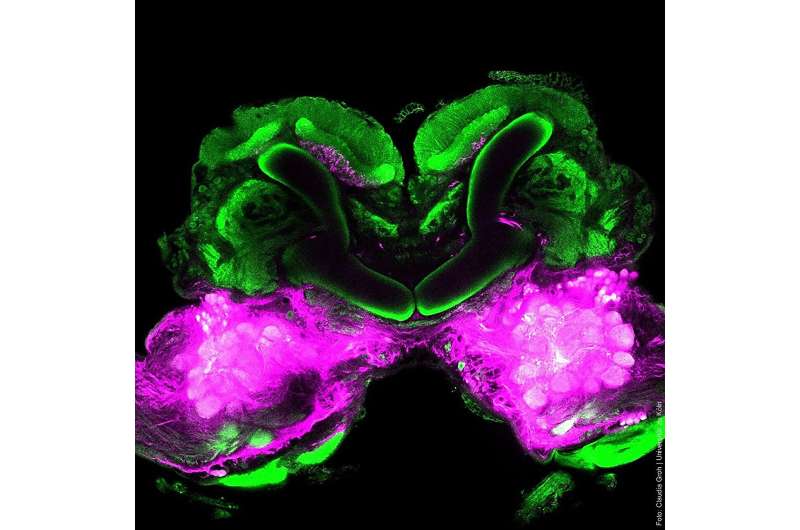This article has been reviewed according to Science X's editorial process and policies. Editors have highlighted the following attributes while ensuring the content's credibility:
fact-checked
peer-reviewed publication
trusted source
proofread
Brain circuit study finds control of behavioral decisions is similar in insects and mammals

The mushroom body—the learning and memory region in the brains of arthropods—is responsible for the ability of insects to make abstract behavioral decisions, which are then carried out by downstream motor networks.
That is the result of a study conducted by Professor Dr. Martin Paul Nawrot and Dr. Cansu Arican from the "Computational Systems Neuroscience" working group at the University of Cologne's Institute of Zoology. The research was reported in Current Biology under the title "The mushroom body output encodes behavioral decision during sensory-motor transformation."
For a long time, the prevailing view among researchers had been that insects react in a robotic manner according to simple stimulus-response patterns, but this assumption has changed greatly over the past two decades. "Insects have simple cognitive skills such as memory formation and recall as well as experience-dependent decision making. Despite their comparatively small brains, they exhibit complex behavioral patterns," said Professor Nawrot.
In invertebrate insects and mammals—and thus also humans—the necessary processes of the nervous system follow similar basic principles in many respects. This includes a rapid sensory processing of environmental conditions and their evaluation, a comparison with acquired experience (and accordingly a reliable decision between possible options of behavior) and ultimately the physical execution of a behavioral sequence.
15 years of research on a brain circuit
An important processing region in the central brain of the insect, known as mushroom body due to its anatomical shape, is crucial for the formation of memory. In the last 15 years, various research endeavors have shown that memory information is encoded by the valence of a sensory stimulus at the output of the mushroom body.
Within the framework of the research group FOR 2705 "Dissection of a Brain Circuit: Structure, Plasticity and Behavioral Function of the Drosophila Mushroom Body," the Cologne team led by Professor Nawrot is also contributing to this research field.
Insects determine whether a certain stimulus has previously been memorized as positive (for example, a scent that promises food) or as negative (for example, a scent of pathogenic substances such as harmful bacteria in the food). Recent studies have also shown that the output neurons of the mushroom body also evaluate sensory stimuli that are relevant for innate behavior, i.e. behavior not based on experience.
Description of a new function of the mushroom body
In this latest study, lead author Dr. Cansu Arican describes how she measured the activity of the output neurons of the mushroom body in the American cockroach (Periplaneta americana) in her experiments, at the same time filming the feeding behavior of the animals. This large insect species was chosen because it has a much larger brain than the fruit fly Drosophila, which often serves as a model organism in basic research.
This allowed for the electronic measurement of neuronal signals, making it possible to simultaneously measure and interpret both the stimulus activity with different food odors and the neuronal responses in the mushroom body—and ultimately the animal's feeding behavior—as a possible behavioral response to the stimulus with high temporal precision.
The research team observed that the mushroom body output neurons not only encode the valence of a particular odor, for example the odor of food compared to a neutral odor, they also form a decision on the execution of the respective feeding behavior based on this information.
They make the behavioral decision not only on the basis of the information of this valence; the current state of the animal is also important, for example whether it is hungry or not at that moment. In the respective trial and on the basis of the neural response pattern, it was thus possible to accurately predict whether the animal would show the feeding behavior only about a tenth of a millisecond later.
Similar to the motor areas of the cerebral cortex in the human brain, the mushroom body thus makes a first behavioral decision and sends an abstract motor command to the downstream motor network—in the case of humans, this is the spinal cord—which then executes the behavior by activating the relevant muscles.
"This result contests the prevailing view of the mushroom body, which can now be seen as a center for memory formation and behavioral decision-making. This is important because research on insect brains is also relevant for understanding the function of more complex brains," Dr. Cansu Arican summed up the results.
More information: Cansu Arican et al, The mushroom body output encodes behavioral decision during sensory-motor transformation, Current Biology (2023). DOI: 10.1016/j.cub.2023.08.016
Journal information: Current Biology
Provided by University of Cologne




















